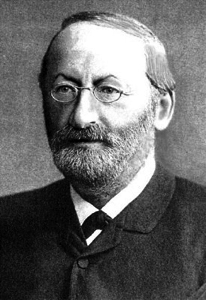
Ferdinand Cohn
Encyclopedia

Germany
Germany , officially the Federal Republic of Germany , is a federal parliamentary republic in Europe. The country consists of 16 states while the capital and largest city is Berlin. Germany covers an area of 357,021 km2 and has a largely temperate seasonal climate...
biologist
Biologist
A biologist is a scientist devoted to and producing results in biology through the study of life. Typically biologists study organisms and their relationship to their environment. Biologists involved in basic research attempt to discover underlying mechanisms that govern how organisms work...
.
Cohn was born in Breslau in the Prussian
Kingdom of Prussia
The Kingdom of Prussia was a German kingdom from 1701 to 1918. Until the defeat of Germany in World War I, it comprised almost two-thirds of the area of the German Empire...
Province of Silesia
Province of Silesia
The Province of Silesia was a province of the Kingdom of Prussia from 1815 to 1919.-Geography:The territory comprised the bulk of the former Bohemian crown land of Silesia and the County of Kladsko, which King Frederick the Great had conquered from the Austrian Habsburg Monarchy in the 18th...
. At the age of 10 he suffered hearing impairment. He received a degree in botany
Botany
Botany, plant science, or plant biology is a branch of biology that involves the scientific study of plant life. Traditionally, botany also included the study of fungi, algae and viruses...
in 1847 at the age of nineteen at the University of Berlin. He was a teacher and researcher at University of Breslau for his entire career. In the 1850s he mostly studied algae. In the 1860s he studied plant physiology in several different aspects. From 1870 onward he mostly studied bacteria. He published over 150 research reports during his lifetime. The University of Breslau became an innovative center for plant physiology and microbiology while he was there.
Cohn was the first to classify algae
Algae
Algae are a large and diverse group of simple, typically autotrophic organisms, ranging from unicellular to multicellular forms, such as the giant kelps that grow to 65 meters in length. They are photosynthetic like plants, and "simple" because their tissues are not organized into the many...
as plant
Plant
Plants are living organisms belonging to the kingdom Plantae. Precise definitions of the kingdom vary, but as the term is used here, plants include familiar organisms such as trees, flowers, herbs, bushes, grasses, vines, ferns, mosses, and green algae. The group is also called green plants or...
s, and to define what distinguishes them from green plants. His classification of bacteria into four groups based on shape (sphericals, short rods, threads, and spirals) is still in use today. Among other things Cohn is remembered for being the first to show that Bacillus
Bacillus
Bacillus is a genus of Gram-positive, rod-shaped bacteria and a member of the division Firmicutes. Bacillus species can be obligate aerobes or facultative anaerobes, and test positive for the enzyme catalase. Ubiquitous in nature, Bacillus includes both free-living and pathogenic species...
can change from a vegetative state to an endospore
Endospore
An endospore is a dormant, tough, and temporarily non-reproductive structure produced by certain bacteria from the Firmicute phylum. The name "endospore" is suggestive of a spore or seed-like form , but it is not a true spore . It is a stripped-down, dormant form to which the bacterium can reduce...
state when subjected to an environment deleterious to the vegetative state.
In 1885 he received the Leeuwenhoek Medal
Leeuwenhoek Medal
The Leeuwenhoek Medal, established in 1877 by the Royal Netherlands Academy of Arts and Sciences, , in honor of the 17th- and 18th-century microscopist Antoni van Leeuwenhoek, is granted every ten years to the scientist judged to have made the most significant contribution to microbiology during...
.

